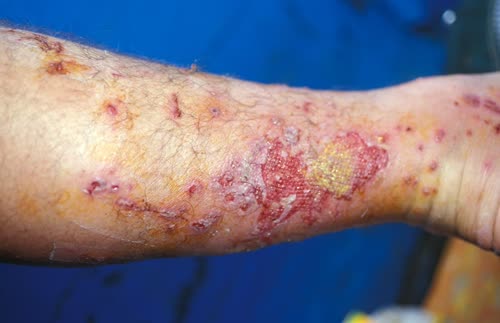|
Employees may have been exposed to potentially dangerous pathogens
More than a dozen employees may have been exposed to potentially dangerous pathogens in incidents at Winnipeg's National Microbiology Laboratory over a 22-month period.
There were 14 cases involving possible exposures in 45 incident reports between January 2015 and October 2016, which were released under an access to information request.
Those incidents include problems with biosafety suits, contaminated needle pricks and equipment malfunctions which led to individuals coming into contact with samples of HIV, Ebola and tuberculosis, among other contaminants.
|
CDC keeps secret its mishaps with deadly germs
"In an August 2014 email with a subject line of “Lab Incident,” CDC blacked out the name and title of the writer. The author started the note: "When I came in this morning.” Then the agency has blacked out about 10 lines of text, citing the bioterrorism law. The agency, however, did disclose the writer’s final sentence: “Please let me know if you have any questions.”
"The CDC also redacted every word in a lab accident report from December 2013 that apparently involved a dangerous strain of influenza virus."
In an effort to determine the extent of the CDC’s lab-safety problems, USA TODAY filed a request on Jan. 6, 2015 under the Freedom of Information Act (FOIA) seeking copies of lab incident reports for the previous two years .
But the 503 pages of records the CDC released in many cases look like Swiss cheese when an incident involves any pathogen that is on a federal list of potential bioterror pathogens, called “select agents.” They include pathogens such as those that cause anthrax, Ebola, plague or certain avian or reconstructed flu virus strains.
The CDC cites a 2002 bioterrorism law to justify its redactions. That law allows withholding from the public certain records filed with regulators or information containing specific “safeguard and security measures.”
However, in many cases, the CDC blacked-out information from lab incident reports that the agency often promotes when touting its capabilities and accomplishments on its website or in scientific journals, such as the fact that the CDC operates biosafety level 4 labs, the highest safety level, or that it studies specific organisms like the Ebola virus.
The CDC said it stands by its redactions.
|
The deadly germ warfare island abandoned by the Soviets
During the Cold War, Vozrozhdeniya Island was a top-secret testing ground for deadly Soviet super-pathogens. Despite over two decades of abandonment, their legacy lives on.

Heiko Bleher collected here - and contracted cutaneous Anthrax.
|
US government lifts ban on risky pathogen research
The National Institutes of Health will again fund research that makes viruses more dangerous.
The US government has lifted its controversial ban on funding experiments that make certain pathogens more deadly or transmissible. On 19 December, the National Institutes of Health (NIH) announced that scientists can once again use federal money to conduct ‘gain-of-function’ research on pathogens such as influenza viruses. But the agency also said that researchers’ grant applications will undergo greater scrutiny than in the past.
The goal is to standardize “a rigorous process that we really want to be sure we’re doing right”, NIH director Francis Collins told reporters.
The NIH announcement ends a moratorium on gain-of-function research that began in October 2014. Back then, some researchers argued that the agency’s ban — which singled out research on the viruses that cause flu, severe acute respiratory syndrome and Middle East respiratory syndrome (MERS) — was too broad. The 21 projects halted by the policy included studies of seasonal flu and efforts to develop vaccines. The NIH eventually allowed ten of these studies to proceed, but three projects using the MERS virus and eight dealing with flu remained ineligible for US government grants — until now.
|
|
|
|
Canada: In 1937, Sir Frederick Banting, who was awarded the Nobel Prize in
1923 for the co-discovery of insulin, began agitating for Canada to organize a germ warefare
program.
Although his efforts met with considerable opposition, both in Canada
and the United Kingdom, exploratory research was under way by mid-1940. During
the war, the Canadians investigated several biological warfare agents, including
the pathogens responsible for anthrax, brucellosis, and tularemia, and they
produced small quantities of B. anthracis for munitions testing. Canadian facilities
tested several biological weapons, including the British Mark I, a 4-pound
bomblet filled with the agents causing brucellosis and tularemia. Botulinum toxin
also was a part of the program; the Canadians tested a cluster munition that dispensed
darts coated with the poison. The Canadian effort should be seen not as
an independent activity but rather as a component of the larger British and U.S.
programs. The Canadians developed no operational BW capability.88
A Short History of Biological Warfare: From Pre-History to the 21 st Century
August 2017 Publisher: US National Defense University Press
Editors note: this US military written, abbreviated history of Germ Warfare leaves out:
- biblical era uses of rabbit fever (tularemia)
- any mention of Biological Weapons used in the Korean war by the US
88 John Bryden, Deadly Allies: Canada’s Secret War, 1937–1947 (Toronto: McClelland
& Stewart, 1989); Donald Avery, “Canadian Biological and Toxin Warfare Research,
Development and Planning, 1925–45,” in Geissler and Moon, 190–214
|
|
American vaccine company working in Canada synthesizes the Horsepox virus from parts of other viruses. This raises the specter that the smallpox virus could be as easily created.
|
Julian Assange opinion piece in the Washington Post
|
|
|

